Motel
A motel is a hotel designed for motorists, and usually has a parking area for motor vehicles.
Entering dictionaries after World War II, the word motel, a portmanteau of motor and hotel or motorists' hotel, referred initially to a type of hotel consisting of a single building of connected rooms whose doors faced a parking lot and, in some circumstances, a common area; or a series of small cabins with common parking. As the United States highway system began to develop in the 1920s, long distance road journeys became more common and the need for inexpensive, easily accessible overnight accommodation sited close to the main routes, led to the growth of the motel concept.[1]
Contents |
History
The earliest known example of a stopping or resting place for travelers with a name pronounced "Motel" began as Motol's tavern or inn on the road from Minsk to Pinsk, probably built in the late seventeenth century, and eventually grew into the township of Motal in Belarus.[2] There is no evidence that this was the source for the English word.

In modern times, auto camps predated motels by a few years.[3] Unlike motels, auto camps and tourist courts typically provided bed and breakfast or hotel style service, usually with stand-alone cabins. After the invention of the motel, auto camps continued in popularity through the Depression years and after World War II, their popularity finally starting to diminish with the construction of freeways and changes in consumer demands. Examples include the Rising Sun Auto Camp in Glacier National Park and Blue Bonnet Court in Texas. Such facilities were "mom-and-pop" facilities on the outskirts of a town that were as quirky as their owners. They attracted the first "road warriors" as they crossed North America in their new automobiles. The 1935 City Directory for San Diego, CA lists "motel" type accommodations under Tourist Camps.
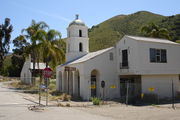
In contrast, though they remained "Mom and Pop" operations, motels quickly adopted a homogenized appearance and were designed from the start to cater purely for motorists.[4] The motel concept originated with the Motel Inn of San Luis Obispo, constructed in 1925 by Arthur Heineman. In conceiving of a name for his hotel Heineman abbreviated motor hotel to mo-tel.[1]
Motels are typically constructed in an 'I'- or 'L'- or 'U'-shaped layout that includes guest rooms, an attached manager's office, a small reception and, in some cases, a small diner. Post-war motels sought more visual distinction, often featuring eye-catching neon signs which employed themes from popular culture, ranging from Western imagery of cowboys and Indians to contemporary images of spaceships and atomic era iconography.
Motels differ from hotels in their common location along highways, as opposed to the urban cores favored by hotels, and their orientation to the outside (in contrast to hotels whose doors typically face an interior hallway). Motels almost by definition include a parking lot, while older hotels were not built with automobile parking in mind.
With the 1952 introduction of Kemmons Wilson's Holiday Inn, the mom-and-pop motels of that era went into decline. Eventually, the emergence of the interstate highway system, along with other factors, led to a blurring of the motel and the hotel, though family-owned motels with as few as five rooms may still be found, especially along older highways.
In the late 20th Century, a majority of the motels in the United States came under the ownership of those of Indian descent, particularly of the Gujarati group.[5]
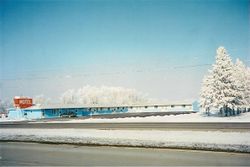
Long-term
Motels / hotels with low rates sometimes serve as housing for people who are not able to afford an apartment or have recently lost their home and need somewhere to stay until further arrangements are made. Motels catering to long-term stays often have kitchenettes.
Short-time
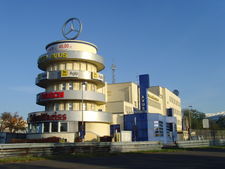
In most countries of Latin America and some countries of East Asia, motels are also known as short-time hotels, offering a short-time or "transit" stay with hourly rates, primarily intended for people having sexual liaisons and not requiring a full night's accommodation. In Mexico, love hotel equivalents are known as "Motel de paso" (Passing Motel), even if they are actually meant mostly access. In Argentina, these establishments are called albergue transitorio ("temporary lodging"), though known as telo in vesre-slang. In Panama, love hotels with individual garages are known as Push Buttons (referring to the button that you push to close the garage door and the other button that grants access to the room). In Paraguay, similarly to Brazil and Colombia, motels may charge only by the hour and are also popularly known as reservados. In Singapore, cheap hotels often offer a slightly more euphemistic "transit" stay for short-time visitors. In Manila, a campaign against the hotels, believed by religious conservatives to contribute to social decay in the predominantly Roman Catholic country, ended with the city banning hotels from offering stays of very short duration. As of May 2010, there are still many short time hotels in operation however under new names to avoid detection by police. In Belgium and France, these establishments are known as hôtels de passe. In Chile, they are known as moteles parejeros (coupling motels), and many of them offer hourly rates. In the United States and Canada, some ordinary motels in low income areas—often called no-tell motels or hot sheet motels—play a similar role to love hotels.
Film, TV and Stage Depictions
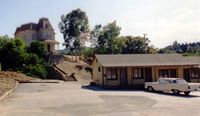
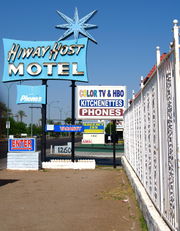
The Bates Motel is an important part of Psycho, a 1959 novel by Robert Bloch and Alfred Hitchcock's 1960 film, Psycho. Film sequels, Psycho II and Psycho III, also feature the motel as does the 1987 television movie, Bates Motel. The motel makes appearances in Psycho IV: The Beginning, but is not featured as much as in previous films. The Bates Motel returned to prominence in the 1998 remake of the original film.
The scenario of an isolated motel being operated by a serial killer, whose guests subsequently become his (or her) victims, has since been exploited in a number of other horror films, notably Motel Hell (1980) and Mountaintop Motel Massacre (1986). More recently, the genre has been revived with such films as Mayhem Motel (2001), Murder Inn (2005), Vacancy (2007), and its direct-to-video prequel, Vacancy 2: The First Cut (2009).
Several of these horror films also incorporate the sub-theme of voyeurism, whereby the motel owner spies on (or even films) the sexual exploits of the guests. This plays on the long-established connotations of motels and illicit sexual activity, which has itself formed the basis for numerous other films, variously representing the thriller, comedy, teen film and sexploitation genres. Stephen C. Apostolof's Motel Confidential (1967) and the porn film Motel for Lovers (1970) were two notably early examples. More recent manifestations include Paradise Motel (1985), Talking Walls (1987), Desire and Hell at Sunset Motel (1991) and the Korean films Motel Cactus (1997) and The Motel (2005).
In countless other movies and TV series, the motel - invariably depicted as an isolated, rundown and seedy establishment - has served as the setting for sordid events often involving equally sordid characters. Examples include Pink Motel (1982), Motel Blue 19 (1993), Backroad Motel (2001), Stateline Motel (2003), Niagara Motel (2006) and Motel 5150 (2008). In the film Sparkle Lite Motel (2006) and the TV miniseries The Lost Room (2006), the motel made memorable forays into the realms of science fiction.
Within the realms of theatre, the seedy motel room has been the setting for a couple of memorable two-hander plays, notably Same Time, Next Year (1975) and Bug (2006). Both were later adapted into films. Broadway musicals have also paid homage to the lowbrow reputation of motel culture, demonstrated by songs such as 'The No-Tel Motel' from Prettybelle and 'At the Bed-D-by Motel' from Lolita, My Love.
Legal issues
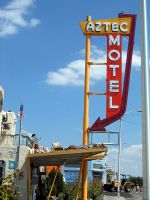
Motels have also served as a haven for fugitives of the law. In the past, the anonymity and the ability to move around easily between motels in different regions by dropping in and checking out with a simple registration process allowed fugitives to remain ahead of the law. However, several changes have reduced the capacity of motels to serve this purpose. Credit card transactions, which in the past were more easily approved and took days to report, are now approved or declined on the spot, and are instantly recorded in a database, thereby allowing law enforcement access to this information. This system was implemented in 1993 after the abduction and murder of Donna Martz, whose credit card was used by her killers, following her death to purchase food, gasoline and to pay for overnight motel stays.[6] The story of Martz's disappearance, leading to the development of this system, was described on The FBI Files. Laws in many places now require registering guests to present a government-issued photo ID, especially when paying with cash. Local law enforcement agencies frequently check motels when they suspect a wanted fugitive is within their jurisdiction.
References
- ↑ 1.0 1.1 Jackson, Kristin (25 April 1993). "The World's First Motel Rests Upon Its Memories". Seattle Times. http://archives.seattletimes.nwsource.com/cgi-bin/texis.cgi/web/vortex/display?slug=1697701&date=19930425. Retrieved 2008-04-02.
- ↑ http://www.shtetlinks.jewishgen.org/motol/
- ↑ Los Angeles Times, "Hanlon before the Council is favoring a site just outside the city limits for an auto tourist camp.," February 8, 1923
- ↑ Bryson, Bill (1996), Made in America, Harper Perennial, ISBN 978-0380713813
- ↑ Varadarajan, Tunku (July 4, 1999). "A Patel Motel Cartel?". New York Times. http://www.nytimes.com/1999/07/04/magazine/a-patel-motel-cartel.html?pagewanted=all. Retrieved 2010-09-01.
- ↑ Bismarck Tribune - Bismarck News - Rodriguez case may revive North Dakota death penalty debate
External links
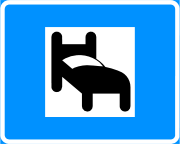
- Motel Americana - a page devoted to history, narratives, and design of postwar motels
- "Motel Memories" - from the Oct. 9 - Oct. 15, 1997 issue of Tucson Weekly
- Motel Signs - A collection of motel signs from around the US
- Motel Directory - A directory of motels from around the US
- WIGWAM Motel - Classic Route 66 Roadside attraction motel built in 1949 and operates as a motel 'til this day.
|
||||||||||||||